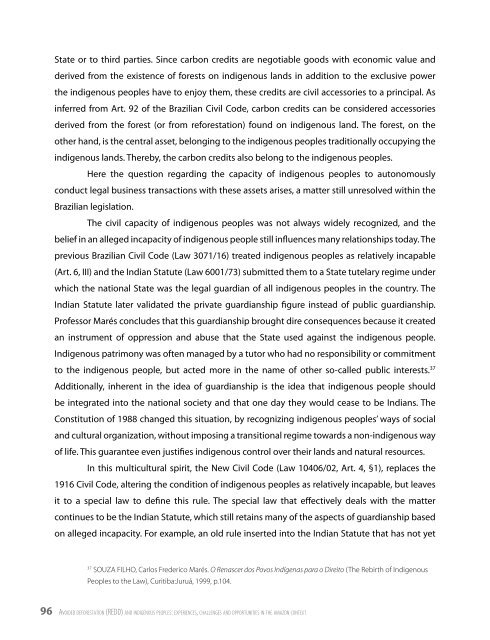Avoided Deforestation (REDD) and Indigenous ... - Amazon Fund
Avoided Deforestation (REDD) and Indigenous ... - Amazon Fund
Avoided Deforestation (REDD) and Indigenous ... - Amazon Fund
Create successful ePaper yourself
Turn your PDF publications into a flip-book with our unique Google optimized e-Paper software.
State or to third parties. Since carbon credits are negotiable goods with economic value <strong>and</strong><br />
derived from the existence of forests on indigenous l<strong>and</strong>s in addition to the exclusive power<br />
the indigenous peoples have to enjoy them, these credits are civil accessories to a principal. As<br />
inferred from Art. 92 of the Brazilian Civil Code, carbon credits can be considered accessories<br />
derived from the forest (or from reforestation) found on indigenous l<strong>and</strong>. The forest, on the<br />
other h<strong>and</strong>, is the central asset, belonging to the indigenous peoples traditionally occupying the<br />
indigenous l<strong>and</strong>s. Thereby, the carbon credits also belong to the indigenous peoples.<br />
Here the question regarding the capacity of indigenous peoples to autonomously<br />
conduct legal business transactions with these assets arises, a matter still unresolved within the<br />
Brazilian legislation.<br />
The civil capacity of indigenous peoples was not always widely recognized, <strong>and</strong> the<br />
belief in an alleged incapacity of indigenous people still influences many relationships today. The<br />
previous Brazilian Civil Code (Law 3071/16) treated indigenous peoples as relatively incapable<br />
(Art. 6, III) <strong>and</strong> the Indian Statute (Law 6001/73) submitted them to a State tutelary regime under<br />
which the national State was the legal guardian of all indigenous peoples in the country. The<br />
Indian Statute later validated the private guardianship figure instead of public guardianship.<br />
Professor Marés concludes that this guardianship brought dire consequences because it created<br />
an instrument of oppression <strong>and</strong> abuse that the State used against the indigenous people.<br />
<strong>Indigenous</strong> patrimony was often managed by a tutor who had no responsibility or commitment<br />
to the indigenous people, but acted more in the name of other so-called public interests. 37<br />
Additionally, inherent in the idea of guardianship is the idea that indigenous people should<br />
be integrated into the national society <strong>and</strong> that one day they would cease to be Indians. The<br />
Constitution of 1988 changed this situation, by recognizing indigenous peoples’ ways of social<br />
<strong>and</strong> cultural organization, without imposing a transitional regime towards a non-indigenous way<br />
of life. This guarantee even justifies indigenous control over their l<strong>and</strong>s <strong>and</strong> natural resources.<br />
In this multicultural spirit, the New Civil Code (Law 10406/02, Art. 4, §1), replaces the<br />
1916 Civil Code, altering the condition of indigenous peoples as relatively incapable, but leaves<br />
it to a special law to define this rule. The special law that effectively deals with the matter<br />
continues to be the Indian Statute, which still retains many of the aspects of guardianship based<br />
on alleged incapacity. For example, an old rule inserted into the Indian Statute that has not yet<br />
37 SOUZA FILHO, Carlos Frederico Marés. O Renascer dos Povos Indígenas para o Direito (The Rebirth of <strong>Indigenous</strong><br />
Peoples to the Law), Curitiba:Juruá, 1999, p.104.<br />
96 Av o i d e d d e f o re s t A t i o n (redd) A n d i n d i g e n o u s p e o p l e s: experiences, chAllenges A n d o p p o r t u n i t i e s in t h e A m A zo n c o n t e x t
















